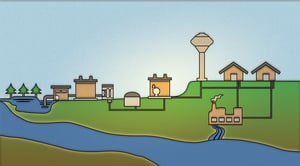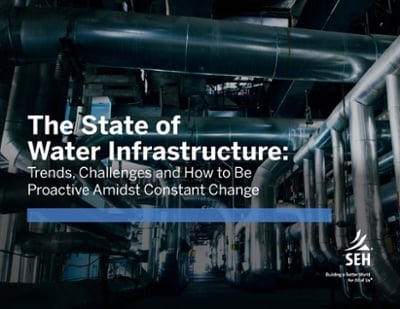This fundamental system keeps fresh, clean water coming into our houses, and takes away the dirty stuff. But people might not realize what actually goes into it.
The urban water cycle is different than the hydrologic cycle, which accounts for environmental condensation, precipitation and evaporation. The urban water cycle is the engineered methods that bring clean water to each of us. These methods and the people that operate them are the unsung heroes in a complex story playing out right beneath our feet.
So, how does clean water reach our homes when we open the tap? Let’s take a closer look at the eight steps of the cycle.
The Eight Main Steps of the Urban Water Cycle
1. Source
The water has to come from somewhere. Often, it comes from surface water like lakes, rivers and reservoirs. But it doesn’t have to. Groundwater can also be pumped up via wells.
2. Treatment
Because water taken from open bodies may contain harmful microorganisms, it has to be treated before it reaches us in our homes. This process can involve a lot of steps. Typical surface water treatment involves chemical coagulation, filtration and disinfection.
3. Distribution
After treatment and sufficient disinfection, the water is sent out via a pressurized system of lifts to the areas in the city where it is needed. A disinfectant residual must be maintained at all parts of the system.
4. Storage
After being distributed, the water is stored in water towers before it is used. Water towers use gravity to make sure sure we have the water when and where we need it.
5. Use
We do it every day. We take showers, brush our teeth, water our lawns, clean our clothes and drink water.
6. Collection
Water leaves our homes by going down our drains and toilets. Sewer systems collect and convey the wastewater from our homes and businesses to wastewater treatment plants. The process is typically done using gravity.
7. Treatment
Because the water quality is reduced by usage, and because it has to be put back into the hydrologic cycle, it has to be treated. This is done through a variety of biological and chemical processes.
8. Discharge
Once the treated water (effluent) has been cleaned to regulatory standards, it is discharged back into the environment. When it gets back to the environment, the cycle starts again.
There is a lot happening when we consider how clean water gets to all of us. The cities and water utilities responsible deserve a pat on the back.
About the Expert

Miles Jensen is a water engineer and regional practice center leader who understands the importance of clean water and the critical role our public facilities play in the process.
*Video Sources:
https://www.usbr.gov/mp/arwec/water-facts-ww-water-sup.html
https://www3.epa.gov/safewater/kids/water_trivia_facts.html
https://www.cdc.gov/healthywater/drinking/public/water_treatment.html
https://www.epa.gov/watersense/how-we-use-water
https://wateruseitwisely.com/journey-pipes-happens-wastewater/
https://freshwaterwatch.thewaterhub.org/content/water-limited-resource
https://www3.epa.gov/npdes/pubs/bastre.pdf



